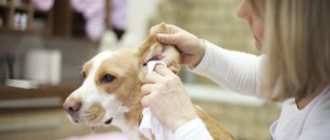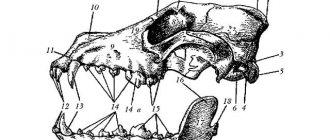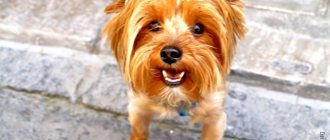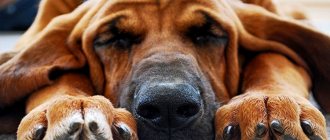Necessary procedures
The main pride and calling card of the Pomeranian Spitz is its luxurious fur coat. It requires a special set of care procedures: from combing to haircuts. But we must not forget that the eyes, teeth, claws and ears of the pet should not be left without attention.
It is also important to promptly deworm, vaccinate the dog and regularly show it to the veterinarian. Now let’s take a closer look at the most important procedures that you can’t do without.
Eyes
Small dogs with long hair often have problems with tearing. The main reason is the ingress of dust, dirt or hair during games or walks. To safely remove discharge from the eyes, you can use a napkin or cotton pad previously soaked in warm water. In addition, experts allow the use of herbal infusions: chamomile or calendula. But, if the discharge begins to be purulent, then you cannot do without a visit to the veterinary clinic and the help of specialists. Only a doctor can determine the etiology of the discharge and prescribe rational treatment. You should not try to sort out medications on your own. An incorrectly chosen drug may not only not work, but also provoke the development of resistance in microorganisms. Consequently, further treatment may be delayed, so do not risk your pet’s health and seek help from qualified specialists.
Teeth
Special pastes, gels and brushes are sold to care for Pomeranian teeth. Caring for them should be daily. Without a brush, you can use a piece of sterile gauze.
Before carrying out procedures, you must wash your hands thoroughly with soap. The puppy is taught to brush his teeth gradually, increasing the time. You should not press hard on your teeth. Movements should be smooth, massaging, so as not to frighten the dog.
To remove plaque, experts recommend giving your pet special treats designed specifically for this purpose once a week. If you miss the moment, then it will be possible to remove tartar only with the help of laser instruments in a veterinary clinic.
Combing
The appearance of the pet depends on how well the owner cares for the pet’s fur. It is recommended to brush the coat at least twice a week. You should not comb the coat every day, because this can damage the structure of the undercoat. The exception is the period of molting - coat change.
This applies to the renewal of puppy fluff, “undressing” of the bitch who has given birth, as well as seasonal shedding twice a year. Daily brushing will help you get through this stage faster. It is advisable to use a slicker brush, which helps prevent the development of tangles, which can then be difficult to deal with.
To make combing easier, some owners recommend using a special spray. After treating the wool with it, you can easily comb it with a comb, which adds volume.
Claws
The frequency of nail trimming depends on the time of year. For example, in the summer, dogs often wear them down on asphalt and hard surfaces on their own. In winter, things are more difficult, so it is important to monitor the length of the claws. Typically, these procedures are carried out at least once every two weeks. Nails that are too long can bend, injuring the paw pads.
For pruning you will need a nail clipper, bandages and peroxide. The latter tools will come in handy if the owner or veterinarian accidentally touches a vessel. There is nothing to worry about, because the bleeding quickly stops. It is difficult to see a blood vessel on dark claws, so the likelihood of such incidents is high.
Don’t forget to reward your pet with treats or praise so that he quickly gets used to unpleasant procedures.
Ears
Ears are probably the easiest thing to take care of. It is enough to inspect the ears a couple of times a week and clean them with a cotton pad soaked in a special lotion.
A healthy dog's ear looks pink and clean. If your pet starts shaking its head, scratching its ears, and you notice an unpleasant odor or brown or yellow discharge, consult a doctor as soon as possible. Perhaps this is the beginning of the development of otitis media or otodectosis (ear scabies). This is also how allergies can manifest themselves, so in order not to guess and make diagnoses yourself, rush to the veterinarian.
A haircut
Haircuts radically change the appearance of a dog. There are several types of hairstyles. A groomer can make a teddy bear or a fox cub from a Spitz. But, the official breed standard today prohibits any modeling of coat. Therefore, if your pet is regularly exhibited, you will have to forget about haircuts. But, if an exhibition career is not part of your plans, then there are absolutely no obstacles to any experiments.
Carrying out the procedure
Before brushing teeth, the owner should wash their hands well and moisten the brush with water. You can give the animal a little paste if it is not familiar with it. Next, a small amount of the product is applied between the bristles of the brush so that your pet does not eat it. Moving the lips away from the teeth, cleaning is carried out with gentle movements along the axis of the teeth. It is not recommended to press too hard in the gum area as this may cause bleeding.
There is no need to try to clean the entire oral cavity in one procedure. Once the animal gets used to it, you can increase the time and thoroughness of cleaning. At the final stage, you need to rinse the brush and reward your four-legged friend. Only pleasant memories should remain from the procedure.
Regular brushing of your Pomeranian's teeth, about 2-3 times a week, will prevent illness, get rid of unpleasant odor and give the animal an attractive appearance. This procedure is one of the basic ones and is mandatory to ensure the pet’s hygiene.
How to properly brush your dog's teeth at home
Hello! I am Nadezhda Petrovna Kulkova, senior veterinarian, specialist in veterinary dentistry...
Hygiene
As for hygiene, in addition to basic washing, it is necessary to clean your pet’s paws after a walk. If you have a male dog, you should wipe and rinse the skin of the prepuce to prevent contamination. This is especially true in damp, wet weather.
Hygienic care of the external genitalia is important. Discharge from them can accumulate on the coat, creating an unpleasant odor and a favorable environment for the development of bacteria. And this will serve as the beginning of unpleasant diseases. The mother usually takes care of the small puppy, cleaning its most inaccessible places. After the mother, responsibility falls on the shoulders of the owner. Adult animals will gradually learn to look after themselves on their own.
Bitches in this regard are much smarter and cleaner. But their hygiene is complemented by some nuances. For example, during the period of heat, you will have to wash the dog’s “pants”, clearing the fur of secretions. After the end of the heat, the specific smell may persist for some time, and in order not to be a bait for the neighbor's males, it is better to bathe the dog entirely. You can also use special sprays that eliminate “girly scents.”
The period of childbirth also requires a special set of hygiene procedures. To facilitate childbirth, it is better to cut off the “pants”, because then the dog sheds a lot. After the end of the birth process, the discharge will have to be washed off from the fur. Nipples also require regular cleaning. Their contamination can lead to the development of mastitis in a nursing mother, and in puppies - to digestive disorders.
Why should a dog brush his teeth?
Even wild animals take care of their oral cavity. For this they do not need special devices. Their diet consists of coarse, fibrous food, which effectively removes plaque.
It’s more difficult for dogs in this regard. Their menu includes either dry food or natural products that do nothing to cleanse tooth enamel. That is why the owners take responsibility for the procedure.
Ignoring hygiene rules leads to serious consequences.
- Over time, the plaque turns into stone;
- gum inflammation develops;
- teeth begin to loosen;
- The dog develops various diseases.
As a result, the pet becomes nervous, restless and lethargic, eats poorly and refuses walks and favorite games. In addition, the bacteria that are in his mouth provoke diseases of the kidneys, liver and heart.
Interesting article: How to properly feed your dog natural food on a small budget
Nutrition
The topic of feeding a Pomeranian is incredibly simple, but there is so much nonsense and conflicting opinions that can be heard on this matter! Is feeding expensive? In general, no. If you don’t pamper your pet with a variety of food, he will eat everything. After all, it is often the owners themselves who are to blame for the fact that the dog begins to be mischievous and choose food.
There is one main rule that must be firmly understood and remembered: forget all human prejudices! Don't worry about diversifying your dog's diet. It doesn’t matter to them that they eat the same food every day; on the contrary, too different menus negatively affect the functioning of the digestive system.
Experts recommend feeding Pomeranians dry food for small breeds of dogs. You should choose brands of ready-made food from reliable, trusted manufacturers. The quality of such products has been repeatedly confirmed by scientific research and the opinion of experienced breeders. Food is available to all people and is sold in every pet store. They perfectly provide the nutrient needs of a living organism.
When choosing food, carefully read the description on the bag. Protein should be at least 25%. It should be animal protein, not plant protein. Vitamins and minerals must be included. It is very important that they are in the correct proportions.
Once you have made your final choice, feed your dog according to the instructions provided on the bag. It is not recommended to constantly change food; it is advisable to do this if your pet has health problems. And switching from one brand to another without compelling reasons rarely occurs without consequences for the body.
As for natural nutrition, it is somewhat more complicated. The basis of the diet should be meat. Sometimes it can be replaced with fish. If it is sea fish, then it can be given fresh, but river fish must be frozen and cooked. For cereals, buckwheat or rice is preferred. As for fruits or vegetables as a source of fiber, you should be careful - some types can cause food allergies.
Small puppies are fed 5-6 times a day, and at about six months they switch to two meals a day.
If you feed your pet dry food, there should always be access to drinking water. And never leave a bag of food within reach of your dog, who might eat it to his heart's content. And overeating threatens to expand the stomach or even stop it.
How to brush your dog's teeth
It is advisable to accustom your pet to the procedure from childhood. What is important is not so much cleanliness as getting the puppy used to the brush and toothpaste. Babies rarely have plaque. It is incredibly difficult to coax an adult dog that is unfamiliar with hygiene. It's good if you come to a compromise. Sometimes you have to brush your teeth with a gauze swab. And this is not the worst option.
Let's share a few tips to help make the procedure less painful for both you and your pet.
1. For cleaning, use a special brush for animals. It has shorter bristles than regular toothbrushes. In extreme cases, it is permissible to take a baby brush, but it is better to prefer cloth or gauze.
2. Regular toothpaste is not suitable for dogs. It is highly recommended to purchase the product at a pet store. Pastes for animals do not foam and do not contain unnecessary hazardous substances. Some of them have a pleasant aroma. Of course, by pet standards.
3. Clean each tooth very thoroughly. Often the plaque remains in hard-to-reach places and slowly destroys the fang. Pay special attention to the last molars.
4. Food acid makes it easier to remove plaque. Add tomatoes to your diet if possible. There is no need to feed your pet tomatoes alone, but a spoonful of juice per serving won’t hurt. You can wipe your teeth with a swab moistened with natural tomato juice.
Some owners advise removing the stone themselves in the initial stages. Don't try this at home! You will probably injure your gums and may become infected.
Better try to find a veterinarian who will take on your case. If this is not possible, it is permissible to use the drug Xident . It can handle a small stone.
Food allergies
Food allergy is a pathological reaction of the body to any product from the menu. Typically allergens are economy-class food containing traces of animal protein. The basis of their composition is herbal ingredients that are poorly absorbed by the dog’s body. There is an opinion that the likelihood of developing an allergy to canned food is less than to dry food.
But this does not mean that the price directly affects the risk of allergic reactions. Expensive food contains products that can also cause individual intolerance.
How to detect signs of allergies in a dog:
- Itching - the pet literally tears the ears and skin with its claws;
- Development of edema in the muzzle or limbs;
- rash or redness;
- discharge from the nose or eyes;
- Labored breathing;
- Nausea, vomiting, loss of appetite;
- Anxiety.
It is not enough to identify the signs - it is important to make an accurate diagnosis. Only a veterinarian can handle this by prescribing the necessary examinations. As a rule, an elimination diet is prescribed, the essence of which is to limit the pet in certain foods. Each of the menu components is removed in turn so that you can understand what causes the allergy.
The doctor prescribes a treatment regimen that includes the use of antihistamines, immunomodulatory drugs, and usually hormones. But the most important thing is to follow a hypoallergenic diet.
Tray training
It is necessary to toilet train a puppy immediately after arriving in a new home. Usually the baby defecates after sleeping, eating or active play. Often, breeders begin to accustom puppies to walking on newspapers. In this case, litter box training will not cause any difficulties.
Ask the breeder for old newspapers “with the smell”. Place the tray in a convenient location and place used newspapers inside. Show the puppy the location of the litter box. As soon as you see that he has begun to look for a place for the toilet, quickly take him to the tray. The kid will quickly figure out what's what.
Walk
Start walking your pet after giving the necessary vaccines. Increase your time outdoors gradually. It will be difficult for a small puppy to walk for about an hour; 15 minutes, 2 times a day, is enough for him. At this age, he will receive the rest of his physical activity at home.
And adult dogs are quite active and energetic, so they will need long walks.
Never let your dog off the leash, no matter its size. Perhaps he will not bite strangers, but for him such freedom may turn out to be dangerous. Spitz often pick on other dogs and can run away or get hit by a car.
How to teach a dog to brush its teeth?
It is better to brush the teeth of small and adult dogs in the evening, when they have walked, run around, eaten and are ready to rest. Tired pets resist less. First, you need to let the animal sniff the brush and toothpaste. The latter most often has a pleasant aroma for animals.
During the procedure, you should constantly talk to the dog. If possible, it is better to brush your teeth together. One person will hold it, and the second will take care of business.
But it is recommended to brush your puppy’s teeth in the first few days without a brush, using only a special cleaning product. After he gets used to the taste of the paste, you can begin to fully care for him.
Holding the dog tightly and forcibly unclenching its mouth is strictly prohibited. Because of her fear, she will be afraid of the brush and the process itself for a long time.
You should not stop trying if the animal resists, gets nervous, scratches or bites. The procedure must be carried out every day, even if only for a few seconds. It is important to strictly suppress all attempts to take away the devices used. But if the dog behaves well, you should praise him.
Toys
Toys are necessary regardless of the age of the pet. They are used to distract the dog from damaging furniture or shoes. This is especially true during the period of teeth change, when the baby tries to gnaw on everything. Toys must be appropriate for the size of the dog. Do not use small objects that your pet could swallow.
Plastic toys, squeakers and items containing small parts are not considered the best option. In pet stores you can buy special “gnawers”, balls or bovine bones that your pet will like.
Vaccinations
You cannot go outside until you are fully vaccinated. Before the first vaccination, the puppy is given tablets or a suspension against helminths. It is advisable to do this twice with an interval of 10 days.
After the same period of time, the first vaccine is given, containing killed strains of plague, enteritis, hepatitis and parainfluenza viruses. After three weeks, revaccination is carried out with a drug that additionally contains strains of the rabies virus. This vaccination is mandatory by law.
The animal is then vaccinated every year.
Prevention of parasites
Parasites are divided into two large groups - endo and ecto, which means internal and external. Ectoparasites – ticks and fleas. Endoparasites are helminths. It is better not to wait until the animal becomes a carrier of helminths or fleas. Prevention should be carried out in a timely manner. First of all, the health of not only the dog, but also the people living nearby depends on this.
There are quite a lot of methods to combat parasitic diseases. Pet stores sell aerosols, collars, and flea drops. To protect against ticks, which are dangerous because they infect dogs with a deadly disease - piroplasmosis, special tablets and injections have been invented. It is necessary to treat your dog for ticks twice a year: in spring and at the end of summer.
Your pet should be prevented from becoming infected with helminths once every three months. There are different tablets and suspensions, which are given in dosages depending on the weight of the animal.
How often to clean
How many times should you clean?
At home
At home - twice a week. During breaks, it is better to give your pet various cleansing items: meat bones, specialized bones (synthetic and edible).
The rest of the time you need to carefully monitor the condition of the mouth. If bleeding occurs, rinse with chlorhexidine; if it persists, contact a veterinarian.
In the clinic
Please note that cleaning your home will not completely remove all dirt. Therefore, the owner can use the service at the veterinary clinic - ultrasonic cleaning.
The procedure is performed without anesthesia and is painless. Although, to avoid stress, light anesthesia can be used. The difference between the condition of the dog’s teeth “before and after” is noticeable. A good clinic will show you this in a photo.
How often should you use ultrasonic cleaning? Your pet should be brought to the clinic for examination once or twice a year. Based on the results of examining the mouth, the doctor will recommend cleaning.











